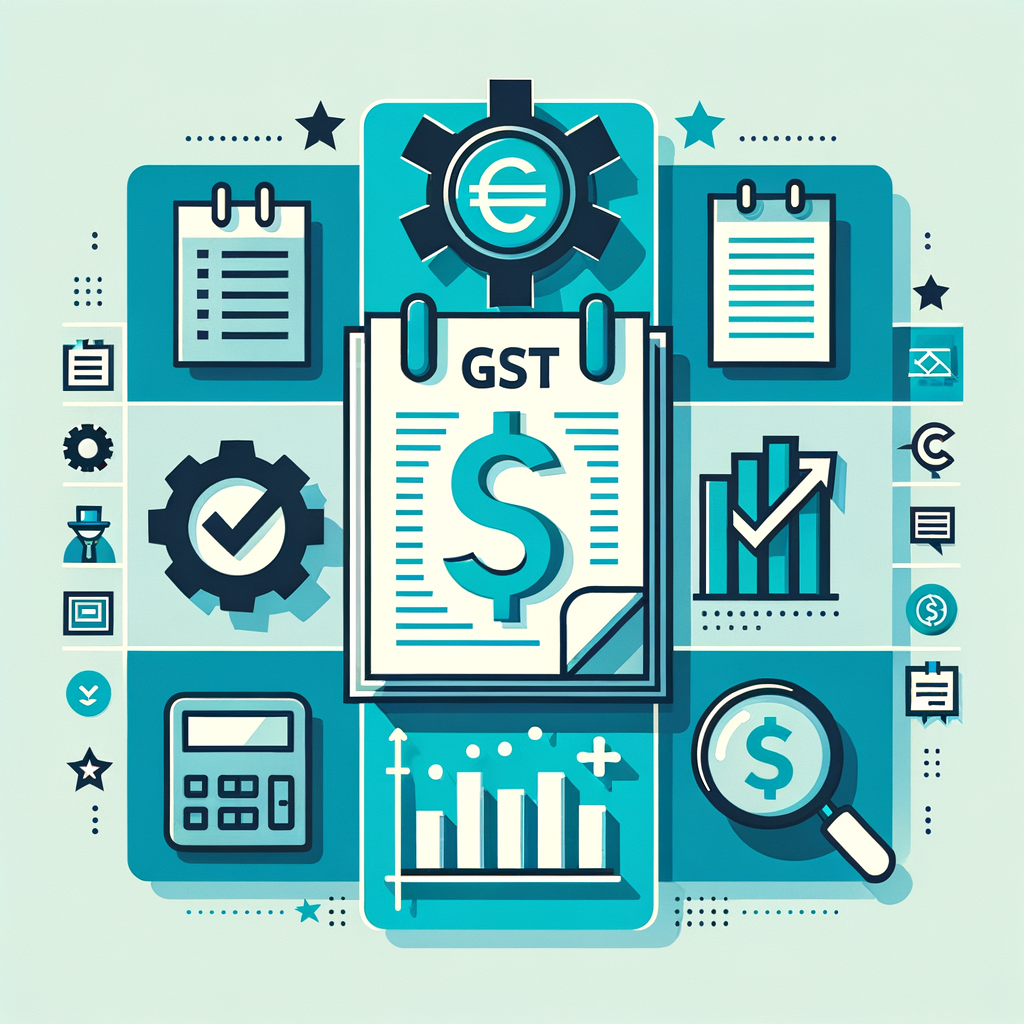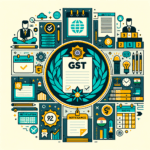Input Tax Credit (ITC) Under GST 2025 – A Complete Guide to the New Claim Rules
One of the biggest promises of the Goods and Services Tax (GST) regime was to eliminate the dreaded “tax on tax” burden that plagued Indian businesses for decades. The powerful mechanism that makes this possible is the Input Tax Credit. Understanding the rules for Input Tax Credit under GST for 2025 is not just about compliance; it’s about safeguarding your business’s financial health and maximizing your cash flow. In simple terms, Input Tax Credit (ITC) is the credit that businesses can claim for the GST they have already paid on their inputs, such as raw materials, capital goods, and various business services. This credit can then be used to reduce their final GST liability on sales. As regulations evolve, staying updated is absolutely critical. This guide is designed for both small business owners looking to optimize their savings and salaried individuals with side hustles aiming to understand their tax obligations and benefits.
What is Input Tax Credit (ITC) and Why Does It Matter?
At its core, Input Tax Credit is the heart of the GST system. It ensures that tax is levied only on the value added at each stage of the supply chain, preventing a snowball effect of taxes that ultimately inflates the cost for the end consumer. To truly appreciate its significance, it’s essential to understand the problem it solves: the cascading effect of taxes. This single concept is the foundation upon which a more streamlined and efficient indirect tax system is built, directly impacting everything from your purchase costs to your final selling price. Without ITC, the GST system would be far less effective, and businesses would face significantly higher tax burdens, making it a cornerstone of modern Indian commerce.
Decoding the “Cascading Effect” of Taxes
Before GST, the tax system was fragmented. Businesses paid multiple taxes like Central Excise, Service Tax, and VAT. Crucially, they often couldn’t get credit for the taxes paid at a previous stage. This meant they were paying tax on a value that already included a tax component—a “tax on tax” or cascading effect.
Let’s illustrate how ITC prevents this:
- Manufacturer: A furniture maker buys wood worth ₹10,000 and pays 18% GST (₹1,800) on it. The total cost is ₹11,800. They then manufacture a table, adding a value of ₹5,000, and sell it to a wholesaler for ₹15,000 + 18% GST (₹2,700).
- Output GST Liability: ₹2,700
- ITC Available (on wood): ₹1,800
- Net GST to be Paid to Government: ₹2,700 – ₹1,800 = ₹900
- Wholesaler: The wholesaler buys the table for ₹15,000 and has an ITC of ₹2,700. They add their margin of ₹3,000 and sell it to a retailer for ₹18,000 + 18% GST (₹3,240).
- Output GST Liability: ₹3,240
- ITC Available (on table purchase): ₹2,700
- Net GST to be Paid to Government: ₹3,240 – ₹2,700 = ₹540
- Retailer: The retailer buys the table for ₹18,000 with an ITC of ₹3,240. They sell it to the final consumer for ₹22,000 + 18% GST (₹3,960).
- Output GST Liability: ₹3,960
- ITC Available (on table purchase): ₹3,240
- Net GST to be Paid to Government: ₹3,960 – ₹3,240 = ₹720
As you can see, at each step, the tax is only paid on the value-added, ensuring the tax burden does not cascade.
Understanding GST Components: CGST, SGST, & IGST
To correctly utilize your ITC, you must understand the different types of GST:
- CGST (Central GST): Tax collected by the Central Government on intra-state (within the same state) transactions.
- SGST (State GST): Tax collected by the State Government on intra-state transactions.
- IGST (Integrated GST): Tax collected by the Central Government on inter-state (between two different states) transactions.
The rule for using your accumulated ITC is specific. The credit from IGST must be used first to pay off IGST liability. Any remaining IGST credit can then be used to pay off CGST and SGST liabilities in any order. After IGST credit is exhausted, CGST credit can be used to pay CGST and then IGST liability (but never SGST). Similarly, SGST credit can be used to pay SGST and then IGST liability (but never CGST). Mastering this sequence is crucial for businesses operating across state lines to manage their tax payments efficiently.
Input Tax Credit Eligibility Criteria: Are You Eligible to Claim?
Claiming ITC is not an automatic right; it comes with a set of conditions that every taxpayer must meticulously follow. Meeting the Input Tax Credit eligibility criteria is the first and most fundamental step in the entire process. Failing to satisfy even one of these conditions can lead to the denial of credit, resulting in higher tax outgo, interest, and potential penalties. Therefore, it is essential for every business owner and professional to have a clear and thorough understanding of these prerequisites to ensure seamless compliance and optimize their financial benefits under the GST framework.
The Fundamental Requirement: GST Registration
The golden rule of ITC is simple: only a person or business registered under GST can claim Input Tax Credit. If you are not registered, you cannot avail the benefits of ITC on the GST you pay on your business purchases. This is a non-negotiable prerequisite. Whether you are a small business owner, a freelancer, or a salaried individual with a side business, if you cross the GST turnover threshold, you must register to take advantage of ITC. Our Ultimate Guide to GST Registration for Small Businesses provides a detailed overview of the process. You can learn more about the process in our guide on How to Register for GST.
The 4 Golden Conditions for Claiming ITC
To claim ITC on any invoice, you must satisfy all four of the following conditions as laid down in Section 16(2) of the CGST Act:
- 1. Possession of a Tax Invoice/Debit Note: You must be in possession of a valid tax invoice, debit note, or other prescribed tax document issued by your supplier. This document must contain all the mandatory details, such as the supplier’s GSTIN, your GSTIN, description of goods/services, value, and the tax charged.
- 2. Receipt of Goods or Services: You must have actually received the goods or services for which you are claiming the credit. In cases where goods are delivered in lots, ITC can only be claimed upon the receipt of the final lot.
- 3. Tax Paid by Supplier: This is one of the most critical conditions. The tax charged on your purchase invoice must have been actually paid to the government by your supplier. This is verified when your supplier files their GSTR-1, and the details reflect in your GSTR-2B. Actionable Tip: Always check the GST compliance rating and filing status of your suppliers on the Official GST Portal before engaging in business to avoid future disputes.
- 4. Return Filing: You, the recipient, must have filed your own GST return, specifically Form GSTR-3B, for the tax period in which you are claiming the ITC. Without filing your return, you cannot claim the credit.
A Note on Input Tax Credit Benefits for Individuals
Many salaried individuals wonder about the Input Tax Credit benefits for individuals. It’s crucial to understand that ITC cannot be claimed on expenses for personal consumption. For instance, you cannot claim ITC on the GST paid for your personal car, home appliances, or restaurant meals. However, the scenario changes if you have a GST-registered side business. If you are a salaried person running a consulting service, an e-commerce store, or any other professional venture on the side, you are eligible to claim ITC on all expenses incurred exclusively for that business. This could include GST paid on a new laptop for work, office rent, internet bills, professional software, or raw materials for products you sell, provided these are supported by proper tax invoices in your business’s name.
The New Input Tax Credit Claim Rules India for 2025
The GST Council and the Central Board of Indirect Taxes and Customs (CBIC) have been progressively tightening the ITC claim process to curb tax evasion and ensure genuine claims. The new Input Tax Credit guidelines for 2025 have solidified this approach, making the process more stringent and system-driven. For businesses, this means that the old ways of provisional claims are gone, and adherence to the new, automated system is mandatory. Understanding these updated Input Tax Credit claim rules India is essential to avoid notices, penalties, and the loss of legitimate credits, directly impacting your working capital.
The Central Role of GSTR-2B: Your Definitive ITC Statement
The most significant change in recent times is the elevated status of Form GSTR-2B. GSTR-2B is an auto-drafted, static statement that is generated for every registered person on the 14th of the succeeding month. It contains details of all the invoices filed by your suppliers in their GSTR-1/IFF.
The Crucial Point: As per the new rules, a taxpayer can ONLY claim ITC that is reflected in their GSTR-2B for that period. This means if your supplier has not filed their return or has filed it incorrectly, that invoice will not appear in your GSTR-2B, and you will not be able to claim the credit for it in that month. This makes GSTR-2B the single source of truth for your eligible ITC, and monthly reconciliation is no longer just good practice—it’s a legal necessity.
Time Limit for Claiming ITC
The law provides a specific deadline for claiming ITC for any invoice pertaining to a financial year. Understanding this rule is critical, as covered in our guide on Time Limits for Availing ITC: Implications of Section 16(4). The time limit is:
- The 30th of November of the next financial year, OR
- The date of filing the Annual Return (GSTR-9) for that financial year,
whichever is earlier.
For example, for an invoice dated 15th December 2024 (part of Financial Year 2024-25), the last date to claim its ITC would be 30th November 2025, or the date you file your annual return for FY 2024-25, whichever comes first. Missing this deadline means the credit is lost forever.
Understanding Blocked Credit (Section 17(5))
Not all GST paid on business inputs is eligible for ITC. Section 17(5) of the CGST Act specifies a list of goods and services on which ITC is explicitly blocked, regardless of whether they are used for business purposes. It’s vital to be aware of these to avoid making incorrect claims. For a detailed list, you can refer to our article on Blocked Credits Under Section 17(5): What ITC Cannot Be Claimed?. Common examples of blocked credit include:
- Motor vehicles for transportation of persons with a seating capacity of 13 or less (including the driver), except when used for making further taxable supplies (e.g., a car dealership, a taxi service).
- Food, beverages, outdoor catering, beauty treatment, health services, and cosmetic surgery, except when used for making an outward taxable supply of the same category.
- Membership of a club, health, and fitness center.
- Life insurance and health insurance, except where mandated by the government for employees.
- Works contract services when supplied for the construction of an immovable property (other than plant and machinery).
- Goods or services used for the construction of an immovable property on one’s own account.
- Goods lost, stolen, destroyed, written off, or disposed of by way of gift or free samples.
The Step-by-Step Input Tax Credit Process in India
Navigating the Input Tax Credit process in India requires a systematic and disciplined approach. From ensuring your supplier is compliant to reconciling your books and filing your returns accurately, each step is interlinked. A mistake at any stage can disrupt the entire chain and lead to the loss of credit. Following a structured monthly process is the best way to ensure you claim every rupee you are entitled to while remaining fully compliant with the latest regulations. This proactive approach minimizes errors and protects your business from unnecessary tax liabilities.
Step 1: Supplier Invoice Verification
The process begins not with you, but with your supplier. Before you even make a payment, ensure the invoice they provide is GST-compliant. It must clearly mention your GSTIN, their GSTIN, HSN codes, tax rates, and tax amounts. Crucially, your supplier must file their outward supplies return (GSTR-1) by the due date (usually the 11th of the next month). Their timely filing is what ensures the invoice details flow into your GSTR-2B.
Step 2: Monthly Reconciliation with GSTR-2B
This is the most critical step in the modern ITC process. Each month, you must:
- Download your GSTR-2B from the GST portal after it’s generated.
- Compare this statement, line by line, with your own purchase register or accounting records.
- Identify any discrepancies, such as missing invoices or invoices with incorrect details.
Actionable Tip: If an invoice from your purchase records is missing in GSTR-2B, you must immediately contact the supplier. You cannot claim ITC on that invoice until the supplier corrects their filing and it appears in a future GSTR-2B.
Step 3: Claiming ITC in Form GSTR-3B
After reconciliation, you will arrive at the final, eligible ITC figure for the month. This amount is then reported in your monthly summary return, Form GSTR-3B. The auto-populated figures in Table 4 of the GSTR-3B are drawn directly from your GSTR-2B. You must carefully review these figures, make adjustments for any ITC that is ineligible (like blocked credit) or needs to be reversed, and then file the return. For a detailed walkthrough, check our Guide to Filing GSTR-3B.
Step 4: Rule of 180 Days – Paying Your Supplier
There is another important condition attached to ITC. You must pay your supplier for the goods or services (including the tax amount) within 180 days from the date of the invoice. If you fail to do so, the ITC you claimed on that invoice must be reversed. This means you have to add it back to your output tax liability in the month the 180-day period expires, along with applicable interest. However, the good news is that you can reclaim this ITC once you make the payment to the supplier at a future date.
Conclusion
The GST framework is designed to be efficient and fair, and Input Tax Credit is its most vital component. However, the benefits of ITC can only be realized through diligent compliance and a thorough understanding of the rules. The key takeaways for 2025 are clear: strict adherence to the new Input Tax Credit guidelines is mandatory, reconciling your purchases with GSTR-2B is no longer optional but a legal requirement, and timely communication with suppliers is paramount. Mastering the rules for Input Tax Credit under GST is essential not just for avoiding penalties but for actively managing your business’s financial resources and maximizing savings.
The GST landscape is constantly evolving. Don’t risk losing your hard-earned money due to compliance errors. Let TaxRobo’s GST experts manage your filings and ensure you claim every eligible rupee of Input Tax Credit. Contact Us Today for a Free Consultation!
Frequently Asked Questions (FAQs)
1. What should I do if my supplier’s invoice is not showing up in my GSTR-2B?
You cannot claim ITC for that invoice in the current month. The ITC is available only when it appears in your GSTR-2B. You must immediately contact your supplier and request them to file their GSTR-1 correctly or amend it if there was an error. You can claim the ITC in a subsequent month once the invoice correctly reflects in your GSTR-2B of that month.
2. Can I claim ITC on an invoice from the previous financial year?
Yes, you can claim ITC for a previous financial year, but only up to the specified deadline. The last date to claim such ITC is the 30th of November of the following financial year or the date you file the annual return for that year, whichever is earlier. After this date, the credit is permanently lost.
3. As a freelance consultant, can I claim ITC on my new laptop?
Yes, absolutely. If you are registered under GST and the laptop is purchased and used exclusively for your consulting business, you can claim the ITC on the GST paid. The key is to have a valid tax invoice for the purchase in the name of your GST-registered business.
4. What is the difference between GSTR-2A and GSTR-2B?
GSTR-2A is a dynamic, real-time statement that gets updated every time a supplier uploads an invoice in their GSTR-1. Its data can change throughout the month. GSTR-2B, on the other hand, is a static and final statement for a particular month. It is generated after the GSTR-1 filing deadline has passed and cannot be changed. For this reason, the law now mandates that your ITC claim must be based only on the final, unchangeable figures available in your GSTR-2B.



